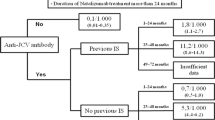Abstract
Mitoxantrone has been approved by the FDA for worsening relapsing remitting and secondary progressive Multiple Sclerosis. However the benefits of this agent in reducing disease progression and relapse rate cannot be sustained in the long-term, as treatment is limited by the potential for cumulative cardiotoxicity. We report our experience utilising Glatiramer Acetate as maintenance immuno-modulatory treatment following initial immunosuppression with Mitoxantrone in a consecutive series of 27 patients with very active relapsing remitting disease, eight of whom had experienced continuing relapse activity on first-line treatment. Duration of treatment with Mitoxantrone and thereby cumulative dose were reduced as our experience with the combination increased.
No unanticipated side effects of combination treatment were encountered over a follow-up period of 66 months. A single patient developed therapy related acute leukaemia (TRAL) 9 months after completion of Mitoxantrone.
A sustained 90% reduction in annualised relapse rate (p < 0.001) has been observed. Disability is stable or improved in all patients a mean of 36 (16–66) months from initiation of treatment. Early suppression of relapse activity with Mitoxantrone has been maintained at a mean of 22 months from last dose of this agent. Only two relapses have occurred in the cohort since withdrawal of Mitoxantrone, occurring in the two patients who had previously been treated with Glatiramer Acetate. In 9 of the first 10 patients treated, imaged a mean of 27 months after withdrawal of Mitoxantrone, no enhancing lesions were identified on MRI brain scans.
Glatiramer Acetate appears a safe and effective option for continuing disease modification in patients with relapsing remitting multiple sclerosis treated with Mitoxantrone. The treatment protocol utilised in later patients in this series appears to have the potential to limit exposure to this agent.

Similar content being viewed by others
References
Millefiorini E, Gasperini C, Pozzilli C, D’Andrea F, Bastianello S, Trojano M, Morino S, Morra VB, Bozzao A, Calo’ A, Bernini ML, Gambi D, Prencipe M (1997) Randomized placebo controlled trial of Mitoxantrone in relapsing remitting multiple sclerosis: 24 month clinical and MRI outcome. J Neurol 244:153–9
Edan G, Miller D, Clanet M, Confavreux C, Lyon-Caen O, Lubetzki C, et al. (1997) Therapeutic effect of mitoxantrone combined with methylprednisolone in multiple sclerosis: a randomised multicentre study of active disease using MRI and clinical criteria. J Neurol Neurosurg Psychiatry 62(2):112–118
Scott TF, Schramke CJ, Cutter G (2003) Sample size estimates for determining treatment effects in high-risk patients with early relapsing-remitting multiple sclerosis. Mult Scler 9: 289–292
Hartung HP, Gonsette R, Konig N, Kwiecinski H, Guseo A, Morrissey SP, et al. (2002) Mitoxantrone in progressive multiple sclerosis: a placebo-controlled, double-blind, randomised, multicentre trial. Lancet 360(9350):2018–2025
Correale J, Rush C, Amengual A, Goicochea M (2005) Mitoxantrone as rescue therapy in worsening relapsing-remitting MS patients receiving IFN-beta. J Neuroimmunol 162(1–2):173–83
Comi G, Filippi M, Wolinsky JS, European/Canadian Glatiramer Acetate Study Group (2001) European/Canadian Multicenter, Double-Blind, Randomized, Placebo-Controlled Study of the Effects of Glatiramer Acetate on Magnetic Resonance Imaging-Measured Disease Activity and Burden in Patients with Relapsing Multiple Sclerosis. Ann Neurol 49(3):290–297
Voltz R, Starck M, Zingler V, Strupp M, Kolb HJ (2004) Mitoxantrone therapy in multiple sclerosis and acute leukaemia: a case report out of 644 treated patients. Mult Scler 10(4):472–4
Fox E, Al-Sabbagh A, Bennett R, Sadiq S (2005) Safety and tolerability of Novantrone (mitoxantrone) in clinical practice: status report from the Registry To Evaluate Novantrone Effects in Worsening MS (RENEW) study. Program and abstracts of the American Academy of Neurology 57th Annual Meeting; April 9–16, 2005; Miami Beach, Florida. Abstract S46.008
Pryce G, O’Neill J, Croxford J, Amor S, Hankey D, East E, Giovannoni G, Baker D (2005) Autoimmune tolerance eliminates relapses but fails to halt progression in a model of multiple sclerosis. J Neuroimmunol 165(1–2):41–52
Goodin DS, Arnason BG, Coyle PK, Frohman EM, Paty DW (2003) The use of mitoxantrone (Novantrone) for the treatment of multiple sclerosis. Report of the Therapeutics and Technology Assessment Subcommittee of the American Academy of Neurology. Neurology 61:1332–1338
Author information
Authors and Affiliations
Corresponding author
Additional information
Received in revised form: 19 September 2005
Rights and permissions
About this article
Cite this article
Ramtahal, J., Jacob, A., Das, K. et al. Sequential maintenance treatment with glatiramer acetate after mitoxantrone is safe and can limit exposure to immunosuppression in very active, relapsing remitting multiple sclerosis. J Neurol 253, 1160–1164 (2006). https://doi.org/10.1007/s00415-006-0178-z
Received:
Accepted:
Published:
Issue Date:
DOI: https://doi.org/10.1007/s00415-006-0178-z




